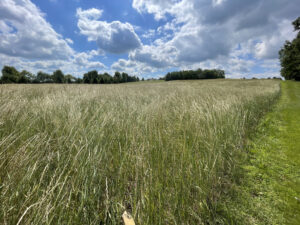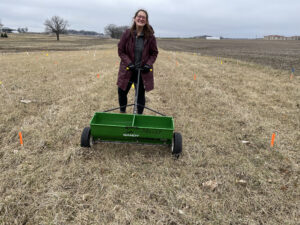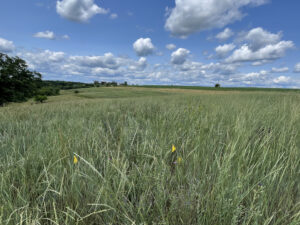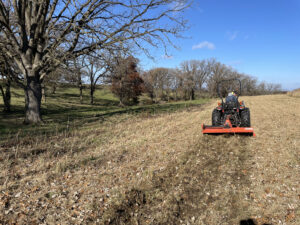Final report for GNC22-356
Project Information
The main project outcome is to demonstrate an organic and conventional agronomic management practice in farmer fields in WI to maintain grain yield over time. In 2021 and 2022, similar research experiments were performed at UW-Madison research stations using a conventional practice, thinning with herbicides, to remove Kernza IWG rows. Because many Kernza IWG farmers use organic management practices, this project also uses an organic practice, tillage, to remove Kernza IWG rows. The experimental sites are two farms in Wisconsin in their third season of Kernza IWG production. Ross Bishop is the conventional no-till farmer located in Washington county, and Halee and John Wepking are beginning organic farmers located in Iowa county.
The approach is to use the optimal level of stand thinning demonstrated at the UW-Madison research sites for maintaining grain yield. At the organic site, a Subsoiler will disrupt roots with minimal surface disruption to thin the Kernza IWG stand. At the conventional site, rows will be thinned using herbicides. The two treatments, no thinning and thinning, will be replicated four times per site. The experimental fields will be fertilized with nitrogen in the spring of 2023, monitored through the summer, and harvested in late summer 2023.
The project will be evaluated using data collected during the 2023 field season. Plant height and plant growth stage will be monitored throughout the summer of 2023. Grain yield, forage yield, and weed biomass will be harvested in the late summer of 2023. All samples will be weighed and dried, and grain will be threshed and weighed using a mechanical thresher at the UW-Madison West Madison research station. Dry weights will be used to run ANOVA and Tukey HSD tests at a 0.05 significance level to detect treatment effects and mean differences.
Results will be published in Agronomy Journal. The results of this experiment will provide Kernza IWG farmers with recommended agronomic management practices to maintain their grain yields overtime, addressing a major concern with Midwest producers. If this project shows similar results to the research station trials, it will provide even more evidence that a simple agronomic practice can extend the life of an economically viable Kernza IWG stand by maintaining grain yield overtime. In turn, this can increase the profitability and longevity of a field of Kernza IWG.
This project primarily addresses Kernza IWG farmers in the North Central Region and secondarily addresses the surrounding community. The primary learning goal is to provide Kernza IWG farmers with evidence and education that thinning stands reduces intraspecific competition and maintains grain yields overtime. If this practice is adopted, the learning outcome should increase profitability of Kernza IWG systems from higher grain yield and stand longevity. This outcome will occur through extension publications and updated agronomic management practice recommendations provided to producers from the Land Institute.
The primary action outcome is that farmers will adopt the management practice of thinning their stands to the recommended level to maintain grain yields. This will be evaluated through on-going surveys that ask farmers about their agronomic management practices to maintain grain yield, whether or not they adopted the thinning practice, and the results of, or barriers to, adoption. This will directly evaluate the project success and direct future research and communication to address farmer needs.
The secondary learning outcome is that the surrounding community including other Kernza farmers will learn about Kernza IWG and the on-going research between local farmers and the university through field days, elementary-school farm visits, social media, and publications. Long-term, this will help foster a stronger local food system and introduce potential consumers and farmers to the environmental, social, and economic benefits of Kernza IWG.
Cooperators
- (Educator and Researcher)
Research
Experimental Design
In the fall of 2022, following the harvest of Kernza grain and forage from farmers' fields during the summer, plots were designated in each field using a 2 x 2 randomized complete block design. The thinning factor involved two conditions: 1) thinned and 2) not-thinned (control), while the fertilization factor included two options: 1) fertilized with 75 kg N ha-1 and 2) not-fertilized (control). Four different locations within each field (4 replications) were selected to apply each treatment, and the assignment of each treatment within a block was done randomly. A example treatment map is illustrated in Figure 1. The choice of the fall season for applying these treatments stemmed from prior research conducted on aging Kernza fields at UW research stations. The findings indicated that thinning applied in the spring showed no impact in the year when the treatments were applied but had a positive effect on yield in the subsequent year (Shoenberger et al., in prep, 2024).
| Thinned x fertilized |
Non-thinned x Fertilized |
|
Non-thinned x non-fertilized |
Thinned x non-fertilized |
Figure 1 : An example of a treatment block replicated 4 times in each field.
Conventional farm
For the conventional farm (Image 1), the fertilization treatment was applied in late October using a GANDY push spreader (Image 2) with 44-0-0 coated urea at a moderate rate of 75 kg N ha-1. This rate was selected based on previous research conducted at UW research stations, demonstrating that a moderate fertilizer rate significantly enhances grain yield. Notably, a high rate (150 kg N ha-1) did not result in higher grain yields compared to the moderate rate, which is why we chose a moderate rate forthis study (Shoenberger et al., in prep, 2024). Thinning treatments were applied using Roundup POWERMAX via a backpack sprayer. Herbicides were employed to eliminate a band of approximately 8 inches with a 16-inch gap between each row.
Image 1 - Conventional farm owned by Ross Bishop of Jackson, WI
Image 2 - Lead researcher, Erica Shoenberger, fertilizing intermediate wheatgrass
Organic farm
In late October, on the organic farm (Image 3), 10-0-2 Purely Organic Lawn Food was applied at a rate of 75 kg N ha-1. Thinning treatments on the organic farm were executed using a tiller (Image 4). The tiller implements were removed to ensure that, akin to the conventional field, approximately 8 inches were tilled with a 16-inch gap between each row.
Image 3 - Organic farm owned by John and Halee Wepking of Ridgeway, WI
Image 4 - Applying organic thinning treatment using a tiller
Data collection
In Late October 2022, all treatments were applied. Subsequently, each month, spanning from early May to early August 2023, measurements were taken for stand height and stage, and the count of vegetative and reproductive tillers was recorded. On August 8, 2023, grain, forage, and weed biomass were collected using quadrats in each plot. The collection involved cutting spikes, forage, and weeds with a rice knife, followed by separation and drying in driers at the UW-West Madison research station for a period of 10 days until a constant mass was achieved. The dried components were then weighed for analysis. After the spikes were dried, the clean grain underwent threshing using a mechanical thresher. Finally, to determine 1000-grain weight (TGW), 100 grains of cleaned dried grain were counted, weighed, and multiplied by 10.
Citations
Shoenberger, E., Stoltenberg, D., Picasso, V (2024). Nitrogen fertilization, but not stand thinning, maintains Kernza intermediate wheatgrass yields over time. [Manuscript in preparation]. Agronomy Journal
Results
Grain yield, forage yield, harvest index (HI), and weed biomass were tested for normal distribution and homogeneity of variance by assessing residual plots. Data were analyzed through a one-way ANOVA in RStudio. Weed biomass was square-root transformed to meet ANOVA assumptions and back-transformed for presentation. The linear mixed model was analyzed using the lmer function from the lme4 package, considering all treatments and farm type (conventional or organic) as fixed effects, and block (nested within location) as a random effect. Interactions with all fixed effects were evaluated and analyzed separately if significant at α = 0.05. Post-hoc mean comparison was performed using the Tukey honest significant difference (HSD) test at α = 0.05. The data for the sites were pooled in Model 1 where Yijkm = grain yield, forage yield, HI, or weed biomass; 𝝻 = the overall mean; Li = effect of farm type; Nj = effect of N fertilizer; Tk = effect of thinning; Bm = block; Eijkm = random residual
Yijkm = 𝝻 + Li + Nj + Tk + Bm + Li*Nj + Li*Tk + Nj*Tk + Li*Nj*Tk + Eijkm [1]
Grain yields
- The type of farm (conventional or organic) had a significant impact on grain yields (p=0.04). The conventional field exhibited a greater grain yield than the organic field, with values of 401 and 213 kg grain ha-1, respectively.
- N fertilization did not impact grain yields (p=0.5).
- The effect of thinning was dependent on the type of farm (thinning*farm type interaction p=0.003). Though overall, thinning did not impact grain yield, the conventional location demonstrated a significantly higher grain yield when thinned compared to the organic location (448 vs. 150 kg ha-1, respectively).
Forage yields
- Farm type had a significant impact on forage yield (p=0.001). The mean forage yields for conventional and organic fields were 4800 and 2900 kg ha-1, respectively.
- N fertilization did not have an impact on forage yields (p=0.2).
- Thinning resulted in a reduction of forage yield (p=0.01). The mean for thinned treatments was 3100 kg ha-1, whereas non-thinned treatments yielded 4600 kg ha-1.
Weed Biomass
- Farm type and N fertilization had no impact on weed biomass.
- Thinning lead to an increase in weed biomass (p=0.02). Thinned plots had a mean weed biomass of 1900 kg ha-1 while non-thinned plots had only a mean of 760 kg ha-1.
Discussion
Farm type: The mean grain yield on the conventional farm exceeded that of the organic farm by 88%. Though both farms planted the same variety of intermediate wheatgrass (TLI-C5), the conventional field was 3 years old at the time of grain harvest while the organic field was 4 years old. It is well documented that Kernza intermediate wheatgrass grain yield declines over time (Hunter et al., 2020; Jungers et al., 2017; Zimbric et al., 2020). Thus, it is reasonable to assume that the age of the field can explain some of why the conventional field had a greater grain yield than the organic field. Following a similar trend, the forage yield on the conventional farm was 66% greater than the organic farm. In the year of planting, the conventional farmer used an herbicide to control weeds in the newly established stand while the conventional farmer did not manage weeds. It is possible that the conventional field established better than the organic field because of the additional management, potentially contributing to greater grain and forage yields.
Nitrogen fertilization: It is intriguing that, in this study, N fertilization exhibited no discernible impact on either grain or forage yield. While previous research has indicated that N fertilization doesn't always affect grain yields in the establishment year of Kernza (Fernandez et al., 2020; Jungers et al., 2017), numerous studies in the Midwest highlight a significant influence on grain yield in aging stands (2+ years) (Rebesquini et al., 2022). The absence of a similar trend in our study raises questions. In hindsight, collecting soil samples at each site to quantify fertility levels could have provided valuable insights. It's conceivable that the sites already had sufficient fertility, delivering the necessary N to intermediate wheatgrass.
An additional factor complicating the detection of N fertilization impact on the organic farm is the presence of a substantial amount of alfalfa and clover in the field. Given that these legumes contribute N to nearby plants, they might have supplied enough N to the control plots (where N was not added), rendering the added N impact indiscernible.
Thinning impact: Overall, thinning had no significant impact on grain yield. However, the thinned conventional location exhibited nearly a 200% greater yield than the organic location. As previously observed, the organic field consistently showed lower mean grain and forage yields, and this pattern persisted in the thinned treatments. Across both locations, thinning resulted in a 33% reduction in forage yield. While some reduction in forage yield was expected, the extent of reduction was not anticipated, especially considering that the thinning was carried out the fall before the harvest. It is plausible that the reduction in forage yield may be attributed to the 150% increase in weed biomass with thinning. This additional weed biomass likely created direct competition with intermediate wheatgrass for light, space, and nutrients. This competition could elucidate both the decline in forage yield and the absence of a discernible effect on grain yield despite the thinning process.
Citations
Fernandez, C.W., Ehlke, N., Sheaffer, C.C., & Jungers, J.M (2020). Effects of nitrogen fertilization and planting density on intermediate wheatgrass yield. Crop Economics, Production, & Management, 112(5), 4159-4170. doi:10.1002/agj2.20351
Hunter, M.C., Sheaffer, C.S., Culman, S., & Jungers, J.M. (2020a). Effects of defoliation and row spacing on intermediate wheatgrass I: Grain production. Agronomy Journal, 112(3), 1748–1763. doi:10.1002/agj2.20128
Jungers, J.M., DeHaan, L.R., Betts, K.J., Sheaffer, C.C., & Wyse, D.L. (2017). Intermediate wheatgrass grain and forage yield responses to nitrogen fertilization. Agronomy, Soils, and Environmental Quality, 109(2), 462-472. doi:10.2134/agronj2016.07.0438
Rebesquini, R.B., Basche, A., Jungers, J., Culman, S., Picasso, V. (2022). The impact of nitrogen rates across sites and years of intermediate wheatgrass grain yields: A meta-analysis. [Poster presentation]
Zimbric, J.W., Stoltenberg, D.E., Picasso, V.D (2020). Effective weed suppression in dual-use intermediate wheatgrass systems. Agronomy Journal, 112, 2164-2175. doi: 10.1002/agj2.2019
Educational & Outreach Activities
Participation Summary:
Consultations:
When initiating this project, I engaged in phone conversations with four existing Kernza farmers to determine the optimal field and suitable participants. After identifying the two participants, I maintained regular communication, conducting discussions both over the phone and in person, totaling at least four interactions each. These conversations focused on project details, timelines, determining the most suitable treatment for their farming systems, and, in the case of the conventional grower, exploring options for selling their Kernza grain.
Factsheet:
I distributed one factsheet on Kernza and Kernza research in Wisconsin during field days and conferences to provide information to farmers who were interested in participating in on-farm research with UW-Madison.
Journal Article:
The data gathered from this project will be incorporated into a journal article scheduled for publication in late spring 2024 in Agronomy Journal.
Shoenberger, E & Picasso, V (2024). Agronomic practices to manage competition in Kernza intermediate wheatgrass to sustain grain yield over time. [Manuscript in preparation]. Agronomy Journal
Published press articles:
Edible Madison article called Kernza: A Promising Wondergrain. Access here
Webinars, talks and presentations:
- November 2023: Virtual research presentation at the Perennial Farm Gathering: The scope of on-farm research on Kernza in Wisconsin
- October 2023: Flash talk + poster presentation at the American Society of Agronomy Conference in Saint Louis, MO: Does N fertilization and thinning maintain Kernza yields overtime?
- July, 2023: Panelist at the Lake Pepin Legacy Alliance Kernza Fest and Benefit Concert, Stockholm, Wisconsin. I discussed on-farm research in Wisconsin (including this SARE project) and answered farmers questions who are interested in growing and marketing Kernza.
- July 2023: Radio show guest on A Public Affair Radio Show. I shared expertise on the benefits of perennial agriculture and discussed the landscape of Kernza research in Wisconsin with the lead Kernza breeder at The Land Institute in Salina, KS. Access the recording here.
- Dec 2022: University of Wisconsin-Madison public master's defense: Agronomic practices to manage competition in dual-use Kernza intermediate wheatgrass to sustain grain yield over time
- October 2022: Poster presentation at the American Society of Agronomy Conference in Baltimore, MD: Managing inter-row spacing and N fertility in dual-use Kernza intermediate wheatgrass to sustain grain yield over time
Workshop / field days
Presented on this research at the Organic Grains Field Day, West Madison Agricultural Research Station, Madison, WI in May 2023.
Project Outcomes
The primary impact of this project lies in establishing the Kernza farmer network in Wisconsin, a foundation for collaboration with research initiatives at University of Wisconsin-Madison and beyond. The project's emphasis on collaborating with farmers and conducting extensive interviews to comprehend the successes, challenges, and barriers to adopting more sustainable agricultural practices is crucial for shaping public university research and extension efforts. While the project's results suggest that thinning aging Kernza stands may not be economically viable for farmers, its most significant impact is evident in the subsequent grants and efforts for on-farm research and collaboration with farmers across Wisconsin.
Initially exploring the potential effectiveness of thinning aging Kernza stands to stimulate grain yield, the evidence from the two studied farms revealed that it would not be economically beneficial for these farmers to implement such practices. Despite the disappointment in not finding a clear solution to boosting Kernza grain yield over time, the project provides valuable insights, ensuring that farmers' time and resources are not wasted on implementing ineffective thinning practices in aging stands.
Although the environmental benefits were not quantified in this study, the established Kernza farmer network, as a follow-up to this work, is actively addressing environmental considerations. This includes modeling soil erosion and phosphorus loss from Kernza fields across Wisconsin and collecting extensive deep soil samples to evaluate soil health indicators during the life of a Kernza stand.
Socially, the project has brought forth numerous benefits. Hosting field days, promoting Kernza through various channels such as radio, Edible Madison magazine, Kernza festivals, and conferences has increased awareness about Kernza and its potential to improve the sustainability of farming systems in the Midwest. The project has facilitated connections among past and present Kernza farmers, creating a supportive community for learning and mutual support in growing and marketing this novel grain.
This initiative sparked the establishment of a Kernza farmer network in Wisconsin. As a graduate student, one of my key interests lies in direct collaboration with farmers, engaging in on-farm research that addresses their needs. My focus is on understanding and mitigating barriers to Kernza adoption in Wisconsin. Driven by this passion, my advisor, Dr. Valentin Picasso, and a collaborative team of researchers, extension professionals, and farmers successfully secured a grant to support my Ph.D. work, which involves exclusively conducting on-farm research with both new and established Kernza farmers.
At the time I received the SARE graduate student grant, I was a Master's student with no prior experience in on-farm research. This project served as a transformative experience, revealing my profound enjoyment of working directly with farmers. Traveling across Wisconsin and collaborating with numerous farmers on their picturesque lands, not only deepened my appreciation for this work but also underscored the crucial importance of farmer collaboration in driving sustainable agriculture change.



